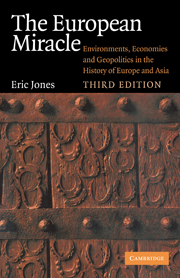Book contents
- Frontmatter
- Contents
- Preface to the third edition
- Preface and acknowledgements
- Introduction to the second edition
- Map
- EURASIA
- EUROPE
- THE WORLD
- ASIA
- 9 Islam and the Ottoman Empire
- 10 India and the Mughal Empire
- 11 China and the Ming and Manchu Empires
- EURASIA
- Afterword to the third edition
- Annotated bibliographical guide to Eurasian economic history in the very long term
- Bibliography
- Supplementary bibliographical guide
- Index
9 - Islam and the Ottoman Empire
Published online by Cambridge University Press: 05 June 2012
- Frontmatter
- Contents
- Preface to the third edition
- Preface and acknowledgements
- Introduction to the second edition
- Map
- EURASIA
- EUROPE
- THE WORLD
- ASIA
- 9 Islam and the Ottoman Empire
- 10 India and the Mughal Empire
- 11 China and the Ming and Manchu Empires
- EURASIA
- Afterword to the third edition
- Annotated bibliographical guide to Eurasian economic history in the very long term
- Bibliography
- Supplementary bibliographical guide
- Index
Summary
I can say no more, then that the disease yet works internally that must ruyne this empire
Sir Thomas Roethe strong point of the Islamic world of the Near East and North Africa lay in obtaining economies of scale by uniting in one faith, one culture and the one Arabic language, a diversity of peoples from Spain across into Asia. For a time this culture, occupying an area greater than the Roman empire, was most innovative. The ‘Arab Agricultural Revolution’ which brought crops from India as far west as Spain was based on extensive culture contact and travel (Watson 1974:17–18). Secular gains were made because of the ambition of every man to make a pilgrimage at least once in his lifetime. Ideas were also diffused in books to an extent beyond the dreams of early medieval Christendom. Large, well-lighted cities with universities and great libraries in Muslim Spain stood in contrast to the virtual hutments and spartan monasticism north of the Pyrenees. The generations are said to have passed into the thirteenth century without plague or famine (Goitein 1973:221).
Scientific and technological knowledge was absorbed from India and China and in some respects developed further. Even at late periods Europe had much to learn from Islam. There was in 1550 a lighthouse in the Bosporus much in advance of any in Europe, 120 steps high, with leaded glass windows and a huge glass lantern lighted by twenty wicks floating in a pan of oil (Beaver 1971:15).
- Type
- Chapter
- Information
- The European MiracleEnvironments, Economies and Geopolitics in the History of Europe and Asia, pp. 175 - 191Publisher: Cambridge University PressPrint publication year: 2003



